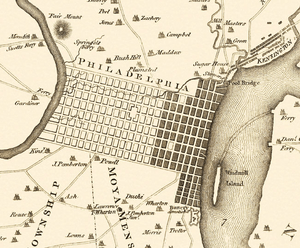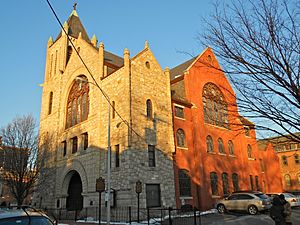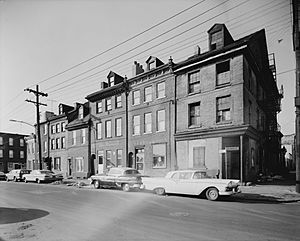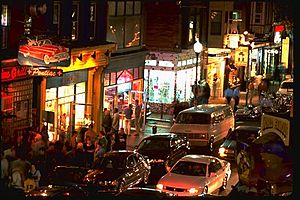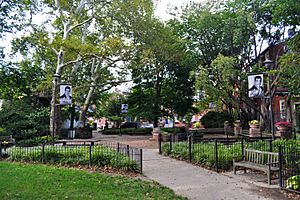Queen Village, Philadelphia facts for kids
Quick facts for kids
Queen Village
|
|
|---|---|
|
Neighborhood
|
|
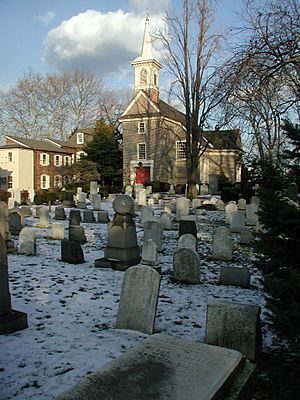
Old Swedes' Church in Queen Village
|
|
| Country | |
| State | Pennsylvania |
| County | Philadelphia |
| City | Philadelphia |
| Area code(s) | 215, 267, and 445 |
Queen Village is a lively neighborhood in Philadelphia, Pennsylvania, in the United States. It's a residential area located on the eastern side of the city, right in South Philadelphia.
This neighborhood shares its borders with Society Hill to the north, Bella Vista to the west, and Pennsport to the south. Its main streets run from Lombard Street in the north to Washington Avenue in the south, and from the Delaware River to 6th Street. Two important shopping areas, South Street and Fabric Row on 4th Street, are also found here.
Historically, Queen Village was part of "Southwark," which was Philadelphia's very first suburb. It became part of the city in 1854 and is known as the city's oldest residential neighborhood. Many people from Jewish and Irish backgrounds have lived here. There's also an Italian-American community, like in much of South Philadelphia.
Contents
History of Queen Village
How Queen Village Started
The first European settlers in what is now Queen Village were part of "New Sweden." This area was originally home to the Lenni Lenapi people, who called it "Wiccaco," meaning "Pleasant Place." Over time, England, the Netherlands, and Sweden all wanted control of this land.
In 1681, a large part of the area came under British control. This happened when William Penn received a land charter. He renamed Philadelphia's first suburban settlement from "Wiccaco" to "Southwark," after a district in London.
A famous building from this early time is Old Swedes' Church (Gloria Dei). You can find it at Christian Street and Columbus Boulevard. It was first built as a strong block-house to protect against the Lenape. The church was finished in 1700 and is now the oldest building still standing in Philadelphia.
How the Area Grew
Even though William Penn planned for the city to grow neatly from east to west, new residents often stayed close to the Delaware River. They preferred to divide Penn's large plots of land or move just south or north of the city. They didn't move much further west than 4th Street.
To meet the demand for homes, builders in Queen Village quickly built houses from wood. This was actually against the law within the city limits after 1796 because of fire risks. Only a few wooden homes still exist in Queen Village today, on streets like South Hancock Street, Christian Street, and League Street.
The Village also had different cultural rules than the main colonial city. Quakers, who were common in Philadelphia, didn't allow theater inside the city. So, Queen Village became a popular spot for theaters. The first permanent playhouse opened here on South Street in 1766.
The "Cedar Street Corridor" (South and Lombard streets from Fifth to Seventh) was a key area for Philadelphia's free Black community. This was during the 1700s and mid-1800s. It was centered around Mother Bethel African Methodist Episcopal Church at Sixth and Lombard. Having free Black churches and affordable homes encouraged African Americans to settle in Queen Village. By 1820, almost two-thirds of all Black families in Philadelphia lived in this area.
By 1830, Queen Village and the southern parts of Southwark were thriving. About 20,000 people lived there. They worked as weavers, tailors, ship builders, sailors, or as machinists and blacksmiths in iron factories.
Military industries were also present. These included the Sparks Shot Tower and the US Naval Ship Yard, just south of Washington Avenue. During the 1840s and 1850s, there were conflicts between rival groups. These included labor unions, street gangs, and fire companies, many of which were based on Catharine and Queen Streets. In 1856, the district officially became part of the city of Philadelphia. A larger police force was then put in place to control the problems, which were mostly caused by economic competition.
By the 1890s, many Jewish people from Eastern Europe settled along South Street and 4th Street. 4th Street became known as Philadelphia's Fabric Row. A lot of Polish people also settled near the waterfront, working as dockworkers. After 1910, many Italian immigrants began arriving and settling in Queen Village and South Philadelphia. This led to very crowded housing conditions. To help with this, groups like the Octavia Hill Association worked to improve housing. This group is still active today.
In the first half of the 1900s, Queen Village became a very diverse neighborhood. It had people from many different backgrounds, including merchants and laborers. They lived in dense communities, similar to New York's Lower East Side.
Challenges and Changes
After World War II, the number of people living in Queen Village started to decrease. Families began moving out of the city to the suburbs. Another big change happened in the 1960s when the I-95 highway was built through the neighborhood. This project, planned by Edmund Bacon, cut off Queen Village from its historic connection to the river. About 300 historic buildings were torn down to make way for the highway.
Bacon also planned a "Crosstown Expressway" on South Street. This highway would have separated Queen Village from Center City, much like the Vine Street expressway separates northern neighborhoods. However, people in the community, led by Denise Scott Brown, successfully fought against this highway. Even though the highway wasn't built, the threat of it caused property values on South Street to drop a lot. This made many long-time businesses leave, leading to empty buildings and neglected areas on South Street.
Around the same time, city planners tried building large public housing projects to house people in high-rise towers. Entire blocks between Christian Street and Washington Avenue were cleared to create the Southwark public housing project.
A New Beginning
South Street began to come back to life in the 1970s. A few important businesses like Eye's Gallery, JC Dobbs, and The Theater of the Living Arts helped start this revival. It grew through a punk rock phase and is now a mix of restaurants, clubs, and shops. This lively area now reaches into Head House Square and 4th Street.
In 1972, a large part of Queen Village was named a historic district. This means it's officially recognized for its important history and buildings. The district stretches from Lombard to Catharine streets and from 5th to Front Street, including the area around Old Swede's Church.
In the 1970s and 1980s, people who wanted to improve the city, sometimes called "urban pioneers" or "gentrifiers," started rebuilding and restoring homes in Queen Village. They also built new ones. The neighborhood was renamed Queen Village after the Queen of Sweden, honoring its earliest settlers.
Today, the South Street-Head House District has over 300 cafes, restaurants, entertainment spots, and shops. Queen Village is now home to about 7,000 families. Their average income and home values are among the highest in Philadelphia. The Queen Village Neighborhood Association helps serve the community.
Historic Buildings
About 800 buildings in Queen Village are listed on the Philadelphia Historical Register. This means they are important for their history.
Some notable buildings include:
- Several homes from the mid-1700s still stand along Front Street between South and Christian Streets. These include the Nathaniel Irish House at 704 South Front Street and the George Mifflin House on the 100 block of Pemberton Street.
- Some studies suggest that the Mason–Dixon line, a famous boundary, might start at Front and South Streets.
- The Sparks Shot Tower is another historic site.
Several buildings are listed on the National Register of Historic Places. These include the Nathaniel Irish House, Widow Maloby's Tavern, William M. Meredith School, Capt. Thomas Moore House, Robert Ralston School, and the South Front Street Historic District. The Gloria Dei (Old Swedes') Church is even more special, as it's a National Historic Landmark.
Education in Queen Village
The School District of Philadelphia provides education for the area. The William M. Meredith School in Queen Village and the George W. Nebinger School in Bella Vista serve different parts of the community. Students from both Meredith and Nebinger schools usually go on to Furness High School.
The Free Library of Philadelphia has the Charles Santore Branch (formerly Southwark Branch) that serves Queen Village. Also, the Independence Branch in Society Hill is available for residents.
Other places for learning and arts include:
- Settlement Music School, located at 416 Queen Street
- Fleisher Art Memorial, at 719 Catharine Street
- Queen Village Art Center, found at 514 Bainbridge Street
- InMovement Studio, at 500 Kenilworth St
Getting Around
Queen Village is served by several bus routes, including the 40, 57, and 64 bus lines.


